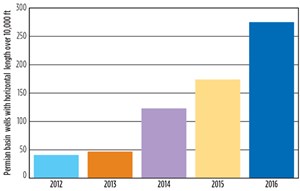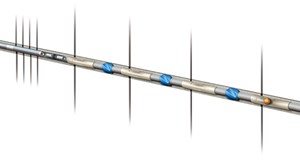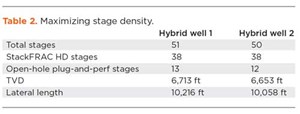Multiple completion technologies yield the best of all worlds
In the quest for higher production, drilling technology advancements have enabled longer and longer laterals to access more of each reservoir. Longer laterals allow for higher stage counts, and a variety of completion technologies have been developed, each with its own benefits and drawbacks.
The term, extended reach lateral (ERL), was coined in the 1980s, referring to wells exceeding a 2:1 ratio of lateral length to true vertical depth. Since then, the definition has expanded to include many wells with a long measured depth (MD), with less focus on the profile. For many operators, a lateral length of 10,000 ft, and longer, would be considered extended reach.

Wells are getting longer quickly. In the Permian basin alone (Fig. 1), the number of wells exceeding 10,000 ft of horizontal length has risen nearly exponentially in the last five years, from less than 50 in 2012 to 275 in 2016, according to data from DrillingInfo. As another example from DrillingInfo data, the average lateral length of Utica wells in the U.S. during 2006 was approximately 7,690 ft. In May 2016, 10 years later, WorldOil.com published a story detailing a record-breaking well that was completed in the Utica shale with a lateral length that was almost 2.5 times longer (18,500 ft).1
One of the primary challenges of ERL completions is stimulating the toe of the well. Operators have begun combining multiple completion technologies in a single well for a hybrid completion approach to address this issue.
The benefits of hybrid systems include:
- Reducing operational risk associated with the conveyance of wireline or coiled tubing in ERLs.
- Effectively stimulating the toe.
- Maximizing inner diameter in the liner.
- Minimizing nonproductive time.
- Reducing water usage and associated costs.
Packers Plus offers solutions for hybrid completions, particularly for toe stages. A number of case histories, using a variety of hybrid combinations, are presented.
PLUG-AND-PERF
Plug-and-perf is often considered the most economical method of well completion, and is by far one of the oldest. This method pre-dates horizontal wells and, as such, the wireline deployed in vertical or slightly deviated wells relied on gravity for downhole conveyance. In horizontal wells, large volumes of water are needed to pump wireline perforating guns to depth, especially if there are doglegs and tight areas. If, for any reason, the tools get stuck, remedial mechanical or hydraulic tools require additional fluid.
Plug-and-perf tools also can be deployed using coiled tubing (CT). One benefit is the ability to continually circulate fluid, which helps condition the well for better conveyance. Circulation also allows better efficiency, as clean-outs and mill-outs can be done immediately following stimulation.
Another advantage of CT is that, theoretically, it can be made to any length. However, there are weight and size limits for transportation, and large spools already have reached the upper limits of transportation regulations using conventional trailers. Specialized, high-capacity reels can be integrated into custom-fabricated trailers with lower beds and more axles. To address weight issues, CT can be made with thinner walls, trading robustness for a longer spool. However, thinner tubing is damaged more easily from buckling, over-pulling or fatigue. For long wells, these restrictions may leave the toe stages out of reach of CT.
Using CT comes with other challenges. When pushing tools to depth, CT tends to spiral, due to cumulative friction. Energized fluid, specialized metal-to-metal lubricants, and tractors or agitators can help with conveyance. If CT is pushed too hard, it can kink or buckle, causing the tubing to become stuck or
to part.
CT-ACTIVATED SLEEVES
Instead of plug-and-perf tools, a shifting tool can be used with CT to mechanically shift sliding sleeves inside the liner. The same benefits and limitations that apply to CT plug-and-perf also apply to CT sleeves.
Furthermore, shifting of CT sleeves requires the maneuvering of downhole tools into small profiles, without the benefit of seeing them. Two critical events that should be confirmed before each treatment are:
- That the CT tool has latched into the sleeve profile.
- That the sleeve has opened.
When a sleeve slides open, it moves only several inches. This is not always perceptible, when tools are 5,000 ft to 10,000 ft deep. It is often difficult to determine if the sleeve moved partially or fully. The exact depth of CT downhole also can cause operational uncertainty, and when combined with the relatively low push strength in extended reach laterals, the result could be lost stages.
Finally, a major disadvantage of CT stimulations is smaller diameter. CT allows only a fraction of the rate possible with a full-bore treatment.
BALL-ACTIVATED SLEEVES
Ball-activated sliding sleeves may be considered a significant development, in that they remove the need for intervention. This has been a major benefit in being able to efficiently complete the lower stages of long wells. However, this technology has, traditionally, had its own limitations in regard to maximum stage counts and restricted inner diameter.
Completion programs using these systems can be executed quickly, using a continuous pumping operation, to utilize specifically sized balls to open their matching sleeves. Not only are ball-activated completions done in a fraction of the time required for plug-and-perf or CT-activated sliding sleeves, they also use significantly less fluid.
When using the smallest balls to maximize stage count, the inner diameter (ID) of a liner can narrow down to one inch at the toe. For operators where maximum production rate is a priority, or future intervention is a possibility, a larger ID at the toe may be desired. Since the biggest ball size is limited to the size of the liner, a larger ball at the toe limits the possible stages.
For a high-density system, tighter ball and seat increments are designed to increase stage counts. However, these narrow tolerances leave a risk of seat erosion—there is an inherent risk of pumping large proppant volumes that impact completion methods in different ways. The combination of fluid velocity and proppant tonnage can result in balls passing through seats where they are intended to land, and open sleeves. To mitigate this, tools can be coated with hardened materials. This has been proven successfully with a number of 50-stage wells completed in the Bakken formation during 2016, using the ball-activated system.
HYBRID COMPLETIONS
Each completion method’s limitations can be resolved, or minimized, by combining technologies. Hybrid completions have become particularly useful for extended-reach lateral wells.
For the toe of extended reach laterals, hydraulic toe sleeves are often favored, regardless of the completion method for the rest of the well. These sleeves are opened hydraulically, without the need for a ball or intervention, and initiate fluid flow into the reservoir from the liner. To lower operational risk and meet legislative requirements, testable toe sleeves are an available option that allow the liner to be pressured up, once or multiple times, before stimulation operations begin.
Ball-activated completions are favored for lower stages, as they do not require extended conveyance by CT or wireline. Ball-activated systems can give operators the flexibility for hybrid systems in open-hole or cemented applications, and single-point entry or limited-entry applications. Ball-activated sleeves in the toe of extended-reach laterals help start treatment faster, and more efficiently, than traditional plug-and-perf methods.
Plug-and-perf or CT sleeves are typical for systems, at the point where ball-activated seats reach the maximum size, or when measured depths for upper stages are within easy reach.
The hybrid combination is driven heavily by operator familiarity, as well as completion design. Common combinations include:
- Plug-and-perf with ball-activated sleeves for limited entry
- CT sleeves with ball-activated sleeves for single-point entry
- Hydraulic toe sleeves with any method or combination.
A hybrid design enables operators to customize a system that takes the best features of each technology.
BREAKDOWN PRESSURES OVERCOME IN THE MONTNEY
An operator working in Alberta’s Montney formation ran a 50-stage, cemented hybrid system. The first 11 stages at the toe were completed using 10 ball-activated Packers Plus Diffusor sleeves and one hydraulically-activated toe sleeve. The remaining stages at the heel were completed using CT-activated sleeves, with a combined lateral length of 9,537 ft.
Given the high formation breakdown pressures seen at the toe, a single-point entry system proved to be effective in ensuring that the desired stimulation treatment was achieved. Pumping fluid directly through the liner, versus using CT, also enabled higher pump rates, Table 1.
BALL-ACTIVATED TOE IN THE MERAMEC
An operator working in the Meramec formation in Oklahoma required an effective treatment method for proppant fracturing at the toe of a cemented plug-and-perf well with a lateral length of 4,620 ft.

Three ball-activated stages, each with five Packers Plus QuickPORT IV sleeves, were installed at the toe, Fig. 2. Stimulation was achieved through each of the sleeves at the designed rate, followed by 20 plug-and-perf stages. The transition time between consecutive ball-activated stages was only about 15 min.
MULTIPLE BENEFITS USING HYDRAULIC TOE SLEEVES
Whether a well is cemented or open-hole, a tool is needed at the toe to move fluid through the liner into the reservoir to initiate stimulation. One efficient tool is a hydraulic toe sleeve, which as the name implies, requires only hydraulic pressure to activate, Fig. 3. Hydraulic toe sleeves do not require intervention.
An operator working in the Cardium used Packers Plus hydraulic toe sleeves with CT sleeve systems for a number of completions since 2015. There were two main advantages of this configuration:
- The operator could stimulate the toe at a high rate, using the full inner diameter of the liner.
- The high flowrate cleaned out any remaining cement or debris to prepare the liner for CT operations.
MAXIMIZING STAGE DENSITY IN THE NIOBRARA
A Colorado operator developing acreage in the Niobrara formation completed a number of wells, averaging 20 stages and 4,300 ft in lateral length. The operator wanted to maximize stage density, as well as complete wells with longer laterals.
Based on designed rates, 50- and 51-stage systems were installed for two separate laterals, each over 10,000 ft. The systems implemented the StackFRAC HD system at the toe of the well, until a full-bore inner-diameter sleeve was achieved. In the heel of the well, RockSEAL H2 packers were used in conjunction with an open-hole, plug-and-perf completion method, Table 2.
OTHER EXAMPLES
Completion technology innovations are driven partially by competition. Some non-Packers Plus hybrid jobs of note include the following:
- A 28-stage, ball-activated, plug-and-perf completion was achieved in the longest horizontal lateral in Argentina. The lower section used 13 ball-activated sleeves with degradable balls, because the depth was beyond the reach of coiled tubing.2
- A flow-through plug-and-perf, and CT sleeve, hybrid completion was executed successfully in a 10,200-ft lateral in the Permian basin.3 Plug-and-perf was used for the lower stages, because it exceeded the reach of CT. Large-bore, flow-through plugs and degradable balls were used specifically to avoid the need for post-stimulation mill-out.
- Drilling technology is slightly ahead of completion technology. Record-breaking wells have been drilled in prolific reservoirs requiring no stimulation. One of the Sakhalin Island wells in Russia has a 39,478-ft horizontal reach, producing from three offshore fields.4 Onshore-to-offshore completions are sure to follow, reducing time, costs and environmental impact.
CONCLUSION
Bearing in mind the benefits and shortcomings for every completion technology, hybrid completions using multiple technologies are becoming more common.
The reach of both wireline and CT has been growing steadily in length and capability. Plug-and-perf or CT is often chosen for upper stages, to lower costs or increase stage counts. However, the operational risks and completion times associated with completing the lower stages of an extended reach lateral can be prohibitive.
Hydraulic toe sleeves and ball-activated completions are often chosen for the lower stages, as they do not require intervention. Ball-activated technologies provide cost- and time-effective solutions for the lower stages of an extended reach lateral, whether the application is cemented, open-hole, limited entry, or single-point entry. By removing the need to trip in and out of the wellbore using CT or wireline, operational risks and completion times can be vastly reduced.
Hybrid completions give operators the flexibility of reducing operational risk and time for the lower stages, while benefiting from the familiarity of plug-and-perf tools for the upper stages. ![]()
- Shale technology: Bayesian variable pressure decline-curve analysis for shale gas wells (March 2024)
- Using data to create new completion efficiencies (February 2024)
- Prices and governmental policies combine to stymie Canadian upstream growth (February 2024)
- U.S. producing gas wells increase despite low prices (February 2024)
- U.S. drilling: More of the same expected (February 2024)
- U.S. oil and natural gas production hits record highs (February 2024)
- Applying ultra-deep LWD resistivity technology successfully in a SAGD operation (May 2019)
- Adoption of wireless intelligent completions advances (May 2019)
- Majors double down as takeaway crunch eases (April 2019)
- What’s new in well logging and formation evaluation (April 2019)
- Qualification of a 20,000-psi subsea BOP: A collaborative approach (February 2019)
- ConocoPhillips’ Greg Leveille sees rapid trajectory of technical advancement continuing (February 2019)




